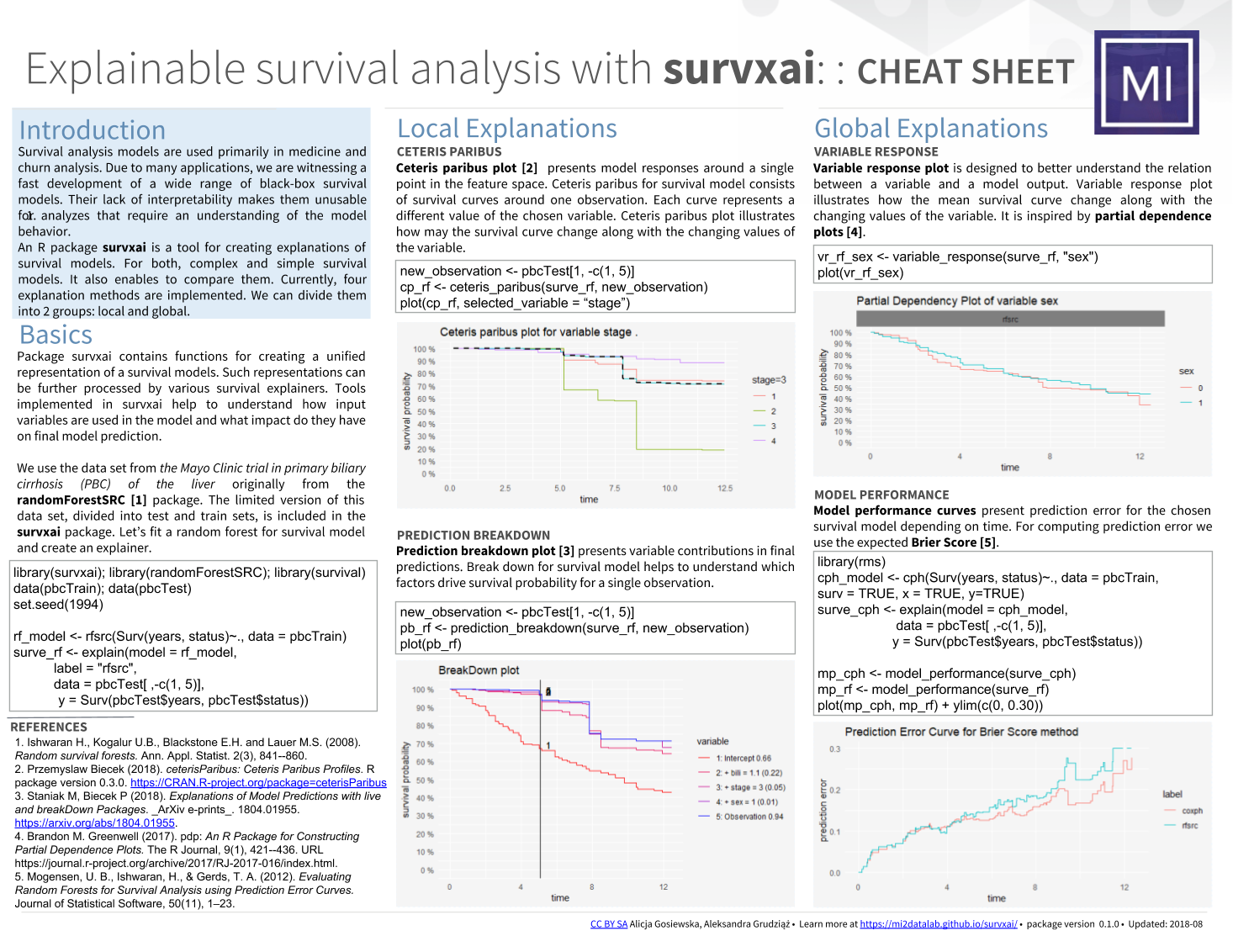NA
104 |108 | How to contribute to survxai
109 |111 | Did you find a bug? 112 |
113 |Please follow these rules when reporting bugs:
114 |-
115 |
Install to the latest version of survxai from GitHub and check whether the problem still occurs.
116 | Check, if the bug was not already reported by searching Issues.
117 | If you’re unable to find an open issue addressing the problem, open a new one. Be sure to include a title and clear description, and a sample code demonstrating the problem.
118 |
122 | Did you fixed a bug? 123 |
124 |-
125 |
Ensure that changes meet the requirements of The tidyverse style guide and relevant tests are added.
126 | Open a new GitHub pull request with the solution.
127 | Ensure the PR clearly describes the problem and solution. Include the relevant issue number if applicable.
128 |
132 | Do you intend to add a new feature or change an existing one? 133 |
134 |-
135 |
- Suggest your change in the Issues and start writing code. 136 |
Thanks!
138 |MI2 team
139 | 31 |
32 |
33 | ## News
34 | Informations about changes in `survxai` relases can be found in [NEWS](https://github.com/MI2DataLab/survxai/blob/master/NEWS.md).
35 |
36 | ## How to contribute
37 | Informations about creating issues and pull requests in `survxai` can be found in [CONTRIBUTING](https://github.com/MI2DataLab/survxai/blob/master/CONTRIBUTING.md).
38 |
39 |
40 | ## Acknowledgments
41 | Work on this package is financially supported by the 'NCN Opus grant 2016/21/B/ST6/02176'.
42 |
--------------------------------------------------------------------------------
/_pkgdown.yml:
--------------------------------------------------------------------------------
1 | template:
2 | package: MI2template
3 | default_assets: false
4 | home:
5 | links:
6 | - text: Source code
7 | href: https://github.com/MI2DataLab/survxai
8 | - text: Contributing guidelines
9 | href: https://github.com/MI2DataLab/survxai/blob/master/CONTRIBUTING.md
10 |
--------------------------------------------------------------------------------
/codecov.yml:
--------------------------------------------------------------------------------
1 | comment: false
2 |
--------------------------------------------------------------------------------
/data/pbcTest.rda:
--------------------------------------------------------------------------------
https://raw.githubusercontent.com/MI2DataLab/survxai/ee5c7df52b347e422efcf028bf2afe652284fb2d/data/pbcTest.rda
--------------------------------------------------------------------------------
/data/pbcTrain.rda:
--------------------------------------------------------------------------------
https://raw.githubusercontent.com/MI2DataLab/survxai/ee5c7df52b347e422efcf028bf2afe652284fb2d/data/pbcTrain.rda
--------------------------------------------------------------------------------
/docs/CONTRIBUTING.html:
--------------------------------------------------------------------------------
1 |
2 |
3 |
4 |
5 |
6 |
7 |
8 |
9 |
31 |
32 |
33 | ## News
34 | Informations about changes in `survxai` relases can be found in [NEWS](https://github.com/MI2DataLab/survxai/blob/master/NEWS.md).
35 |
36 | ## How to contribute
37 | Informations about creating issues and pull requests in `survxai` can be found in [CONTRIBUTING](https://github.com/MI2DataLab/survxai/blob/master/CONTRIBUTING.md).
38 |
39 |
40 | ## Acknowledgments
41 | Work on this package is financially supported by the 'NCN Opus grant 2016/21/B/ST6/02176'.
42 |
--------------------------------------------------------------------------------
/_pkgdown.yml:
--------------------------------------------------------------------------------
1 | template:
2 | package: MI2template
3 | default_assets: false
4 | home:
5 | links:
6 | - text: Source code
7 | href: https://github.com/MI2DataLab/survxai
8 | - text: Contributing guidelines
9 | href: https://github.com/MI2DataLab/survxai/blob/master/CONTRIBUTING.md
10 |
--------------------------------------------------------------------------------
/codecov.yml:
--------------------------------------------------------------------------------
1 | comment: false
2 |
--------------------------------------------------------------------------------
/data/pbcTest.rda:
--------------------------------------------------------------------------------
https://raw.githubusercontent.com/MI2DataLab/survxai/ee5c7df52b347e422efcf028bf2afe652284fb2d/data/pbcTest.rda
--------------------------------------------------------------------------------
/data/pbcTrain.rda:
--------------------------------------------------------------------------------
https://raw.githubusercontent.com/MI2DataLab/survxai/ee5c7df52b347e422efcf028bf2afe652284fb2d/data/pbcTrain.rda
--------------------------------------------------------------------------------
/docs/CONTRIBUTING.html:
--------------------------------------------------------------------------------
1 |
2 |
3 |
4 |
5 |
6 |
7 |
8 |
9 |